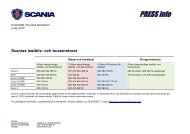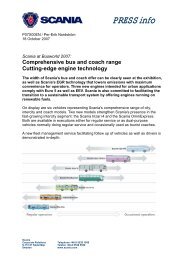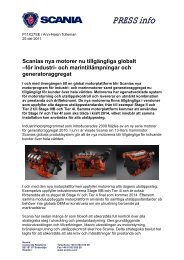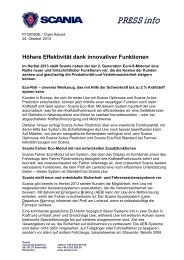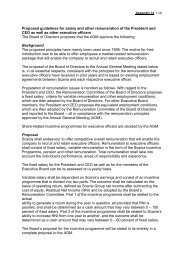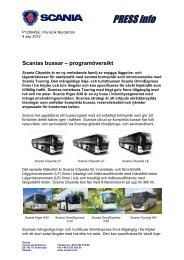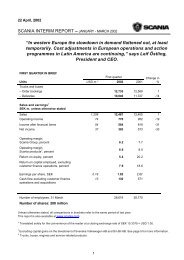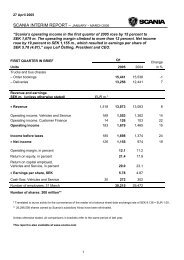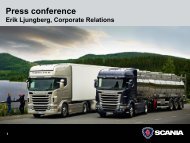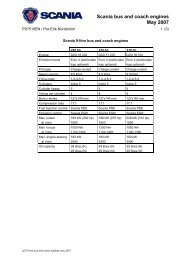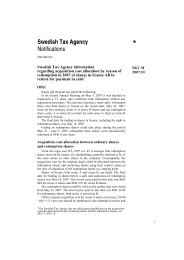Book 1.indb - Scania
Book 1.indb - Scania
Book 1.indb - Scania
You also want an ePaper? Increase the reach of your titles
YUMPU automatically turns print PDFs into web optimized ePapers that Google loves.
A MAGAZINE FOR SCANIA’S SHAREHOLDERS<br />
QUARTER 2 2012<br />
%<br />
Operating Rörelsemarginal<br />
20 20<br />
16<br />
17<br />
12<br />
14<br />
8<br />
11<br />
4<br />
8<br />
0<br />
-10 -06-10<br />
-07-10<br />
-07-11<br />
-07-11<br />
-07-11<br />
-08-11<br />
-08-12<br />
-08-12<br />
-08<br />
Q2 Kv4Q3<br />
Kv1Q4<br />
Kv2Q1<br />
Kv3Q2<br />
Kv4Q3<br />
Kv1Q4<br />
Kv2Q1<br />
Kv3Q2<br />
Kv4<br />
Report.<br />
Xxxx Lower xxx deliveries<br />
xxx and xxx higher xxx<br />
xxx<br />
xxx<br />
xx costs xxx. pulled<br />
down the mar-<br />
> SID 2<br />
gin. > PAGE 2<br />
interview.<br />
Xxxx Focusing xxx on xxxxxx service xxx<br />
xx at <strong>Scania</strong> xxxxxx in xxxx Latin xxxx<br />
xxx America. xxxxxx xxx.<br />
> SID PAGE 3 3<br />
Lower emissions<br />
<strong>Scania</strong>’s broad efforts to reduce environmental impact.<br />
Xxxxx<br />
><br />
xxxx<br />
PAGE<br />
xxxxxxxx<br />
4–5<br />
xx x xxxxxx xxxxx. > SID 4–5<br />
Stock Finance. market.<br />
Xxxx Incentives xxx xxxxxx and<br />
xxx sport xx will xxxxxx get Brazil xxxx<br />
xxxx moving xxx again. xxxxxx.<br />
> SID PAGE 6–7 6–7<br />
FIGURES<br />
FIGURES IN<br />
IN<br />
FOCUS:<br />
FOCUS:<br />
XXX 4.06<br />
Xxxxxx xxx xx<br />
Earnings per share (SEK) in the<br />
xxxx xxxx xxxxx xxx<br />
first six months<br />
xxxx xxxxx xx.
FIRST SIX MONTHS IN FIGURES<br />
order bookings and deliveries by region, Q2 (number of vehicles)<br />
euRoPe<br />
Order bookings<br />
8,150 -14%<br />
Deliveries<br />
7,020 -20%<br />
euRASiA<br />
Order bookings<br />
2,407 -13%<br />
Deliveries<br />
1,736 -11%<br />
LATin AMeRiCA<br />
Order bookings<br />
4,669 +6%<br />
Deliveries<br />
3,234 -42%<br />
AFRiCA AnD oCeAniA<br />
Order bookings<br />
989 -6%<br />
Deliveries<br />
963 -6%<br />
ASiA<br />
Order bookings<br />
3,371 -33%<br />
Deliveries<br />
2,841 -28%<br />
net sales<br />
net sales by product segment*<br />
operating income and margin<br />
SEK m. Other 2%<br />
% Operating income, SEK m.<br />
SEK m.<br />
25,000<br />
Used vehicles 6%<br />
20 Operating margin, percent<br />
4,000<br />
20,000<br />
Services 21%<br />
16<br />
3,500<br />
3,000<br />
15,000<br />
12<br />
2,500<br />
10,000<br />
Engines 2%<br />
Trucks 61%<br />
8<br />
2,000<br />
1,500<br />
5,000<br />
0<br />
2010 Q2<br />
2010 Q3<br />
2010 Q4<br />
2011 Q1<br />
2011 Q2<br />
2011 Q3<br />
2011 Q4<br />
2012 Q1<br />
2012 Q2<br />
Buses and<br />
coaches 8%<br />
*Refers to first half of 2012<br />
4<br />
0<br />
2010 Q2<br />
2010 Q3<br />
2010 Q4<br />
2011 Q1<br />
2011 Q2<br />
2011 Q3<br />
2011 Q4<br />
2012 Q1<br />
2012 Q2<br />
1,000<br />
500<br />
0<br />
Key figures<br />
(SEK m. unless otherwise noted) 2012, 6 m 2011, 6 m Change in %<br />
Net sales, <strong>Scania</strong> Group 39,338 43,665 -10<br />
Operating income, Vehicles and Services 3,944 6,414 -39<br />
Operating income, Financial Services 313 238 32<br />
Operating income 4,257 6,652 -36<br />
Income before taxes 4,275 6,828 -37<br />
Net income for the period 3,249 4,947 -34<br />
Operating margin, % 10.8 15.2<br />
Return on equity, % 23.1 35.0<br />
Return on capital employed, Vehicles and Services, % 29.2 44.2<br />
Earnings per share, SEK 4.06 6.18 -34<br />
Cash flow, Vehicles and Services 1,769 3,218 -45<br />
Number of employees, 30 June 37,802 36,941<br />
Order bookings (units, trucks and buses) 35,395 42,103 -16<br />
Deliveries (units, trucks and buses) 32,032 40,300 -21<br />
First six months<br />
in brief:<br />
DELIVERIES<br />
fell by 21 percent to 32,032<br />
vehicles.<br />
OPERATING INCOME<br />
fell by 36 percent to SEK<br />
4,257 m.<br />
CASH FLOW<br />
amounted to SEK 1,769 m.<br />
2 SCANIA VALUE • Q2/2012 www.scania.com
interview<br />
text: erik aronsson photo: dan boman<br />
Service must be a major focus of<br />
<strong>Scania</strong>’s future expansion in Latin<br />
America, says Martin Ståhlberg.<br />
<strong>Scania</strong> stands strong<br />
in Latin America<br />
Latin America is not only <strong>Scania</strong>’s<br />
second biggest region but also<br />
an important region of the world,<br />
with different countries presenting<br />
different demands and conditions.<br />
Martin Ståhlberg, head of <strong>Scania</strong>’s<br />
Latin American operations, is<br />
focusing on service.<br />
Martin Ståhlberg was appointed head of<br />
<strong>Scania</strong>’s Latin American operations in September<br />
2011. Prior to this, he had served as head of <strong>Scania</strong><br />
in France and Sweden and as Managing Director<br />
of <strong>Scania</strong>’s dealerships in Stockholm. In his current<br />
role, he is in charge of one of <strong>Scania</strong>’s most<br />
important regions.<br />
“Latin America today represents about 20 percent<br />
of <strong>Scania</strong>’s vehicle deliveries and the region<br />
has accounted for reasonably stable growth in<br />
recent years, despite the economic downturn during<br />
2008 and 2009,” says Ståhlberg.<br />
Aside from Brazil, <strong>Scania</strong> has a strong presence<br />
in several other countries where the company has<br />
to meet the specific demands of each market.<br />
“We have a strong brand in all the markets<br />
we operate in. In Mexico, we have a 65 percent<br />
market share for intercity buses. In Peru, there is<br />
strong potential for mining applications but also<br />
for intercity buses. In Venezuela, we have very<br />
successfully launched our industrial engines. In<br />
Colombia and Chile, we have developed our Bus<br />
Systems by <strong>Scania</strong> concept, in which buses occupy<br />
dedicated lanes in a system that resembles railbound<br />
service.”<br />
Distribution segment is important<br />
Yet Brazil is the country to which Ståhlberg is<br />
devoting the greatest attention.<br />
“In Brazil, we are currently focusing on the local<br />
distribution segment but we are also very strong<br />
in long-haulage, in products for the agricultural<br />
industry and in off-road solutions for the construction<br />
and mining sectors,” he says.<br />
One important factor that is reducing demand<br />
in Brazil this year is the transition to the new<br />
Euro 5 emission standard. But according to<br />
Ståhlberg, <strong>Scania</strong> has been able to take advantage<br />
of having been well prepared for the change-over.<br />
“<strong>Scania</strong> has good experience of the Euro 5<br />
technology since it is already available in Europe.<br />
Our customers here are happy with what we can<br />
deliver since they can enjoy the same benefits as<br />
the previous technology in terms of fuel economy<br />
and productivity,” he says, while pointing out<br />
that during the first five months of 2012 <strong>Scania</strong><br />
captured the largest market share when it comes<br />
to sales of Euro 5 vehicles. Overall, the heavy truck<br />
market shrank by 32 percent during the first half of<br />
the year. Demand was strong in both 2010 and 2011.<br />
When it comes to future expansion in Latin<br />
America, Ståhlberg believes that the primary<br />
focus must be on service.<br />
“We are focusing on continued improvement<br />
of our service network and service offering. We<br />
believe that knowledge of our customers’ business<br />
and of our customers’ customers means that<br />
not only can we understand, but also predict what<br />
needs our customers will have. In this way we can<br />
help improve their business.”<br />
www.scania.com Q2/2012 • SCANIA VALUE 3
FOcUs: envirOnMent<br />
<strong>Scania</strong> is working on a broad front and in cooperation<br />
with customers to help reduce the environmental impact<br />
related to carbon dioxide and other substances. Demands<br />
for reduced emissions from the transport sector are<br />
increasing while economic growth means that transport<br />
volume is growing. This represents a great challenge for<br />
vehicle manufacturers and transport companies.<br />
Meeting environmental<br />
challenges<br />
For a long time, there have been regulations which<br />
prescribe limits for discharges of particulates and<br />
nitric oxide. Many countries have introduced the<br />
Euro emission standards, and the Euro 5 standard<br />
currently applies in the European Union, Brazil<br />
and elsewhere. The next stage in Europe will<br />
be the Euro 6 standard, which enters into force<br />
within the EU and certain neighbouring countries<br />
on 31 December 2013 for all new vehicles<br />
that are sold.<br />
<strong>Scania</strong>’s early euro 6 launch<br />
As early as March 2011, <strong>Scania</strong> launched its first<br />
Euro 6 engines in order to give far-sighted hauliers<br />
the opportunity to be one step ahead before<br />
the new emission standard go into effect.<br />
An acknowledgement of the successful launch<br />
came when <strong>Scania</strong>’s R 480 Euro 6 tractor model<br />
recently received the “Green Truck 2012” award<br />
from the respected German trade magazines<br />
Verkehrsrundschau and Trucker. “The good results<br />
achieved by the <strong>Scania</strong> R 480 Euro 6 in these<br />
press tests confirm that <strong>Scania</strong>’s engineers have<br />
done an excellent job in developing the engines,”<br />
says <strong>Scania</strong>’s Managing Director for Germany<br />
and Austria, Alexander Vlaskamp.<br />
The Euro 6 standard means about one fifth<br />
of the emissions of nitric oxide and<br />
particulates compared to<br />
Euro 5. Lower carbon<br />
dioxide emissions is an<br />
area that is in constant<br />
focus since lower fuel<br />
consumption is of great<br />
importance to <strong>Scania</strong>’s customers. However,<br />
there are still no actual regulations regarding<br />
emissions of carbon dioxide for commercial<br />
vehicles. There are many opportunities to reduce<br />
climate impacting emissions aside from improving<br />
the efficiency of the traditional diesel engine.<br />
Alternative fuels are one method.<br />
4 SCANIA VALUE • Q2/2012 www.scania.com
text: erik aronsson Foto: scania<br />
For more than 20 years, <strong>Scania</strong> has worked<br />
with bioethanol as an alternative fuel. Today<br />
bioethanol is the most widely used biofuel in<br />
transport services. It is also the fuel which has<br />
the best prospect of being supplied in large and<br />
enduring quantities in the future, and it offers<br />
the highest cost efficiency and best operational<br />
range of the renewable fuels available at present.<br />
A major advantage is that bioethanol is available<br />
in liquid form and in commercial quantities<br />
all over the world. It is easy to produce from a<br />
variety of different raw materials – such as sugar<br />
cane, beets and cellulose – and it is used both as<br />
pure fuel and as an additive to traditional fuels.<br />
<strong>Scania</strong> is the only vehicle manufacturer to offer<br />
a number of heavy haulage products that can<br />
be powered by bioethanol – for example buses,<br />
trucks and refuse collection vehicles.<br />
<strong>Scania</strong>’s engines for bioethanol fuel have the<br />
same energy efficiency as a standard diesel engine<br />
and meet the Euro 5/EEV emission standards.<br />
“Of course many people want to rely on future<br />
technology, but there is so much we can do even<br />
today. Bioethanol can deliver up to 90 percent<br />
lower CO 2 emissions compared to ordinary diesel,”<br />
says Urban Wästljung, Manager, Sustainable<br />
Transport at <strong>Scania</strong>.<br />
<strong>Scania</strong> is also working on solutions to reduce<br />
CO 2 emissions which as yet are only in the<br />
experimental stage. Some time ago, the car<br />
industry launched electric cars of different kinds.<br />
A major challenge in the case of commercial<br />
vehicles is the limitation in battery technology,<br />
which for example cannot provide enough<br />
capacity for a truck carrying a 25 tonne payload,<br />
driven very long distances.<br />
electric motorways<br />
– a future possibility<br />
However, if a vehicle can obtain electric power<br />
from the roadway itself, the potential will be<br />
much greater. It may sounds a bit like science fiction,<br />
but it is a field where <strong>Scania</strong> even today is<br />
involved in several different projects.<br />
A future system of electrified motorways<br />
has a number of advantages:<br />
there is less environmental impact<br />
from operation of vehicles, electric<br />
engines are more efficient<br />
than ordinary internal combustion<br />
engines and power can be<br />
supplied to the vehicles without<br />
needing to use heavy batteries.<br />
Several interesting projects<br />
relating to electrified roads<br />
are underway in Sweden. One<br />
example is <strong>Scania</strong>’s cooperation<br />
with Siemens regarding electric truck<br />
operation on the road between Pajala and the<br />
iron mine at Svappavaara in far northern Sweden.<br />
There, trucks containing iron ore will drive<br />
“ Bioethanol can deliver up to<br />
90 percent lower Co 2<br />
emissions<br />
compared to ordinary<br />
diesel.”<br />
round-the-clock for reloading to the Iron Ore<br />
Line, a railway that will carry the ore to a port<br />
on the Atlantic coast of northern Norway. In a<br />
recent report, the Swedish Transport Administration<br />
(Trafikverket) stated that electrically-powered<br />
trucks are a realistic alternative. Power supplied<br />
by overhead cables is probably also the best<br />
solution for this service, since the road is built on<br />
bogs and moves up and down.<br />
“Development of our electrified vehicle has<br />
to take place on a step-by-step basis,” explains<br />
Johan Lindström, Expert Engineer at Hybrid<br />
Systems Development, <strong>Scania</strong>.<br />
“We are using electrified gearboxes developed<br />
in hybrid projects, but then a large electrical<br />
motor must be added to the powertrain to drive<br />
90 tonnes of payload entirely by electricity.”<br />
However, some problems would have to be<br />
resolved in order to adapt such a system to<br />
enable both heavy vehicles and ordinary cars to<br />
obtain power from aerial lines.<br />
<strong>Scania</strong> is therefore also examining solutions<br />
where vehicles obtain their power supply from<br />
the roadway through induction or some other<br />
technique. This will deliver a more flexible solution<br />
where all vehicles can use the system and<br />
thus share the large investment cost to rebuild<br />
the road network. A feasibility study from the<br />
Svenska Elvägar (“Swedish Electric Roads”) project<br />
shows that electrification of heavy road traffic<br />
in Sweden would make it possible to reduce<br />
CO 2 emissions by 4.2 million tonnes, equivalent<br />
to 9 percent of national fossil fuel emissions.<br />
Together with Volvo Powertrain, Bombardier,<br />
Alstom and other companies within the transport<br />
industry, <strong>Scania</strong> has applied for funding<br />
from the government-backed Strategic Automotive<br />
Research and Innovation (FFI) research programme,<br />
for a study on electric road transport<br />
systems, which is expected to be completed in<br />
early 2013.<br />
In <strong>Scania</strong>’s view, different solutions will be<br />
required in different markets to make such<br />
systems commercially viable in meeting future<br />
emission challenges. This is due to varying<br />
access to alternative fuels and also depends on<br />
how developed the electrical infrastructure will<br />
be in the future. <strong>Scania</strong> has a good starting position,<br />
given its extensive experience of a modular<br />
product range.<br />
Today’s electric vehicles are often powered by batteries, but such vehicles have a limited driving<br />
distance due to their low storage capacity. <strong>Scania</strong> is therefore evaluating various alternatives for<br />
transferring electricity between roadway and vehicle, including inductive power transfer.<br />
www.scania.com Q2/2012 • SCANIA VALUE 5
Finance: scania in brazil<br />
Brazil<br />
Technology shift in<br />
<strong>Scania</strong>’s largest market<br />
The transition to a new emission<br />
standard and generally weaker<br />
economic conditions have reduced<br />
demand for heavy trucks in Brazil.<br />
But the Brazilian government is<br />
now making an effort to get the<br />
economy moving again, however,<br />
so far the measures have not had<br />
an effect.<br />
Demand for heavy trucks in Brazil has been at<br />
a very high level in recent years, but the transition<br />
to the Euro 5 emission standard during<br />
the first half of 2012 has had a negative impact<br />
on demand. Buyers of new trucks have been<br />
hesitant about assuming the cost implied by an<br />
investment in the new trucks. The shift from<br />
the Euro 3 emission standard to Euro 5 means<br />
that vehicles gain exhaust purification technology<br />
which has not been used in Brazil to date.<br />
Meanwhile the generally weaker economic<br />
conditions have reduced demand throughout<br />
the Brazilian economy, which has also affected<br />
demand for vehicles. The Brazilian government<br />
has tried to get growth moving again through<br />
various incentives and the central bank has<br />
reduced interest rates in several stages. In<br />
April, Brazil’s finance minister Guido Mantega<br />
introduced a package including tax cuts, incentives<br />
to local industry through government<br />
procurement and better financing measures for<br />
export companies.<br />
Reduced growth forecasts<br />
“So far, this has not had a significant effect but as<br />
decisions regarding support are moved out to a<br />
local level we should see a greater effect. Seasonally<br />
adjusted, I think we may start to see a sequential<br />
recovery during the summer even though we do<br />
not expect that registrations and production will<br />
increase compared to last year,” says Björn Enarson,<br />
analyst at Danske Bank.<br />
Mantega has had to reduce the growth outlook<br />
on several occasions and in mid-July<br />
Reuters reported that the GDP forecast had<br />
been cut to 2.5 percent for 2012. In 2011, growth<br />
was 2.7 percent.<br />
However, in the longer term, analysts believe<br />
that there are factors that point towards a good<br />
performance in Brazil. Infrastructure investments<br />
connected to the football World Cup in 2014 and<br />
the 2016 Olympic Games in Rio de Janeiro combined<br />
with the demographic trend and the abovementioned<br />
incentive measures imply a good outlook<br />
for the entire automotive industry.<br />
“We predict a strong rebound in demand and<br />
production of heavy trucks in early 2013 in light<br />
Brazil’s finance minister, Guido Mantega, hopes<br />
to get the country’s economy moving again.<br />
of the recovery within the industrial and the<br />
agricultural sectors, acceptance of new rules for<br />
fuels and engines, and better access to government<br />
incentive measures,” writes the US investment<br />
bank JP Morgan in an analysis.<br />
High average age of truck fleet<br />
JP Morgan also points out in its analysis that the<br />
Brazilian truck fleet, which is estimated to number<br />
about a million trucks, still has a high average<br />
age, suggesting a large replacement need.<br />
The same applies in the bus and coach market.<br />
Transport needs in particular will be in focus<br />
for the two gigantic sporting events that are<br />
planned in Brazil in the next few years. Ahead<br />
of the World Cup in 2014, there are plans for a<br />
number of infrastructure investments and the<br />
government is also hoping for greater economic<br />
activity during the event in the form of tourism<br />
and increased private consumption.<br />
“We believe that the World Cup will have<br />
some positive effect on the market, particularly<br />
as regards construction equipment, thanks<br />
to all of the planned building projects,” says<br />
Enarson.<br />
The 2016 Olympic Games in Rio de Janeiro<br />
will also require extensive infrastructure investments.<br />
In March 2012, Brazil’s President Dilma<br />
Rouseff and Rio de Janeiro’s Mayor Eduardo<br />
Paes announced plans for bus and light rail<br />
transport solutions in Rio that are expected to<br />
cost approximately USD 1 billion, the equivalent<br />
of SEK 8 billion. However, this is a minor<br />
factor when compared to the World Cup.<br />
“The positive effect from the Olympics will<br />
not be as significant since there is only one city<br />
involved,” says Enarson.<br />
6 SCANIA VALUE • Q2/2012 www.scania.com
text: erik aronsson photos: göran wink and vanessa carvalho/getty images<br />
The World Cup in 2014 and the<br />
2016 Olympics in Rio de Janeiro<br />
will require investments in<br />
Brazil’s infrastructure.<br />
Facts Brazil<br />
Area: 8,514,877 km², the world’s<br />
fifth largest country<br />
Population: About 192 million,<br />
the world’s fifth most populous<br />
country<br />
GDP: +2.7 percent (2011)<br />
Currency: Real (100 reais= about<br />
50 US dollars)<br />
Capital: Brasilia<br />
(Sources: IMF, OECD, CIA World Factbook)<br />
www.scania.com Q2/2012 • SCANIA VALUE 7
IN BRIEF<br />
Weak demand for<br />
buses and coaches<br />
<strong>Scania</strong> Production Slupsk, in Poland, is issuing<br />
redundancy notices to 142 employees due to<br />
continued weak demand for buses and coaches<br />
for public transport in the most important markets<br />
for <strong>Scania</strong>’s fully-built buses in the Omni<br />
range. Various support programmes have been<br />
developed in consultations between the company<br />
and the trade unions that for instance will<br />
offer the affected employees the possibility of<br />
early retirement and redundancy payment.<br />
“The economic situation in our most important<br />
markets is showing no sign of improvement,<br />
which means that we expect continued<br />
weak demand for public transport buses in the<br />
coming year. Therefore, we have to adjust production<br />
to significantly lower volume,” says Klas<br />
Dahlberg, Senior Vice President, <strong>Scania</strong> Buses<br />
& Coaches.<br />
The facility in Słupsk, with close to 700 employees,<br />
is the hub of <strong>Scania</strong>’s European production<br />
of fully-built (bodied) buses for public transport.<br />
The <strong>Scania</strong> OmniCity and OmniLink models are<br />
bodyworked here. Chassis for the <strong>Scania</strong> OmniCity<br />
are also assembled in Słupsk. These chassis are<br />
also delivered to other, independent bus bodybuilders<br />
in Europe, Africa and Asia.<br />
editor: erik aronsson photos: scania<br />
Martin Lundstedt named new CEO<br />
The Board of Directors of <strong>Scania</strong> has appointed<br />
Martin Lundstedt the new President and Chief<br />
Executive Officer of <strong>Scania</strong> AB. He takes up his<br />
new position on 1 September 2012 and succeeds<br />
Leif Östling, who has been appointed a member<br />
of the Board of Management of Volkswagen AG.<br />
Martin Lundstedt, born in 1967, has a Master<br />
of Science degree in Industrial Engineering and<br />
Management and is currently <strong>Scania</strong>’s Executive<br />
Vice President and Head of Franchise and<br />
Factory Sales. He joined the company in 1992 and<br />
has held various senior positions including head<br />
of <strong>Scania</strong>’s industrial operations in France from<br />
2001 to 2005 and Senior Vice President, Trucks<br />
until 2007, when he assumed his current position.<br />
<strong>Scania</strong> is well positioned, and Lundstedt sees<br />
no reason to change the path <strong>Scania</strong> has chosen<br />
in recent years.<br />
Martin Lundstedt has<br />
been appointed new<br />
President and CEO of<br />
<strong>Scania</strong> AB.<br />
“We shall continue to be the <strong>Scania</strong> that our<br />
customers appreciate, a small big company<br />
working tightly together with them, always<br />
keeping it simple and straightforward.”<br />
The company’s core values remain in place<br />
and the same goes for <strong>Scania</strong>’s strategies.<br />
“We shall continue to be the premium choice<br />
for all customers in the transport and engine<br />
sectors all over the globe. And we will do that<br />
by building on our strong portfolio of products<br />
and services, in our modular system, and with<br />
a strong emphasis on the sales and services<br />
network.<br />
“Being the premium choice means that<br />
we are working as partners with our customers,<br />
always providing the best return on their investments<br />
over the life cycle of these products.”<br />
First Euro 6<br />
municipal vehicle<br />
<strong>Scania</strong> exhibited the world’s first fully<br />
equipped Euro 6 sewer cleaner vehicle at<br />
the IFAT ENTSORGA trade show, held in<br />
Munich, Germany in May. <strong>Scania</strong>’s modular<br />
product system made the design possible,<br />
also showing that <strong>Scania</strong>’s Euro 6 engines can<br />
be specified for virtually any application on<br />
the market.<br />
“Assembling such a complicated superstructure<br />
on <strong>Scania</strong>’s Euro 6 chassis was really<br />
easy,” says Brian Stage, CEO of Danish-based<br />
bodybuilder J Hvitved Larsen A/S. “The<br />
superstructure is identical to the one we use<br />
for Euro 5 vehicles, which is a major benefit<br />
from a cost- and lead-time standpoint.”<br />
Would you like to subscribe?<br />
For a free subscription, visit<br />
www.scania.com/scaniavalue<br />
UPcoming events<br />
22 October 2012<br />
Interim Report, Jan-Sep 2012<br />
Week starting 29 October<br />
<strong>Scania</strong> Value Quarter 3, 2012<br />
(on www.scania.com and as<br />
a printed version)<br />
<strong>Scania</strong> Value is published by <strong>Scania</strong><br />
and targeted to <strong>Scania</strong> shareholders.<br />
Publisher<br />
Per Hillström, ir@scania.com<br />
Editor-in-chief<br />
anneli.volden@scania.com<br />
Project Manager<br />
erik.aronsson@appelberg.com<br />
Art Director<br />
karin.soderlind@appelberg.com<br />
Production<br />
Appelberg Publishing Group<br />
www.appelberg.com<br />
Printing: Trosa Tryckeri<br />
Cover photo: Dan Boman<br />
Contact<br />
<strong>Scania</strong> Investor Relations<br />
151 87 Södertälje, Sweden<br />
Tel: 08-553 81 000<br />
E-mail: ir@scania.com<br />
8 SCANIA VALUE • Q2/2012<br />
www.scania.com



